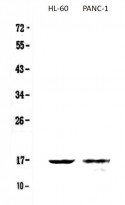ARG58684
anti-Galectin 10 antibody
anti-Galectin 10 antibody for Western blot and Human
Overview
| Product Description | Rabbit Polyclonal antibody recognizes Galectin 10 |
|---|---|
| Tested Reactivity | Hu |
| Tested Application | WB |
| Host | Rabbit |
| Clonality | Polyclonal |
| Isotype | IgG |
| Target Name | Galectin 10 |
| Antigen Species | Human |
| Immunogen | E. coli-derived Human Galectin 10 recombinant protein (Position: S2-R142). |
| Conjugation | Un-conjugated |
| Alternate Names | LGALS10; LPPL_HUMAN; LGALS10A; Galectin-10; CLC; Charcot-Leyden crystal protein; GAL10; Lysolecithin acylhydrolase; Gal-10; Eosinophil lysophospholipase |
Application Instructions
| Application Suggestion |
|
||||
|---|---|---|---|---|---|
| Application Note | * The dilutions indicate recommended starting dilutions and the optimal dilutions or concentrations should be determined by the scientist. |
Properties
| Form | Liquid |
|---|---|
| Buffer | 0.9% NaCl, 0.2% Na2HPO4, 0.05% Sodium azide and 4% Trehalose. |
| Preservative | 0.05% Sodium azide |
| Stabilizer | 4% Trehalose |
| Concentration | 0.5 mg/ml |
| Storage Instruction | For continuous use, store undiluted antibody at 2-8°C for up to a week. For long-term storage, aliquot and store at -20°C or below. Storage in frost free freezers is not recommended. Avoid repeated freeze/thaw cycles. Suggest spin the vial prior to opening. The antibody solution should be gently mixed before use. |
| Note | For laboratory research only, not for drug, diagnostic or other use. |
Bioinformation
| Database Links | |
|---|---|
| Gene Symbol | CLC |
| Gene Full Name | Charcot-Leyden crystal galectin |
| Background | Lysophospholipases are enzymes that act on biological membranes to regulate the multifunctional lysophospholipids. The protein encoded by this gene is a lysophospholipase expressed in eosinophils and basophils. It hydrolyzes lysophosphatidylcholine to glycerophosphocholine and a free fatty acid. This protein may possess carbohydrate or IgE-binding activities. It is both structurally and functionally related to the galectin family of beta-galactoside binding proteins. It may be associated with inflammation and some myeloid leukemias. [provided by RefSeq, Jul 2008] |
| Function | Regulates immune responses through the recognition of cell-surface glycans. Essential for the anergy and suppressive function of CD25-positive regulatory T-cells (Treg). [UniProt] |
| Cellular Localization | Cytoplasm, cytosol. [UniProt] |
| Calculated MW | 16 kDa |
Images (1) Click the Picture to Zoom In






